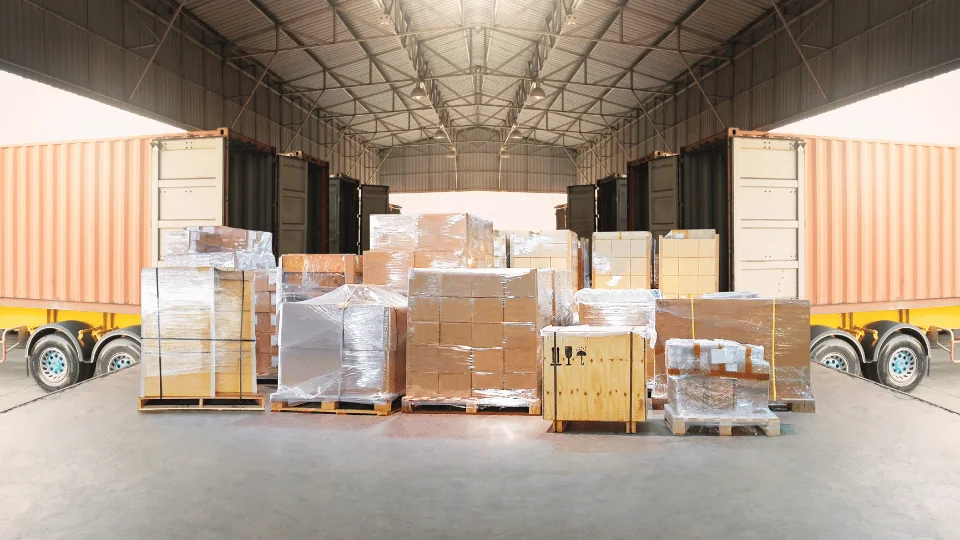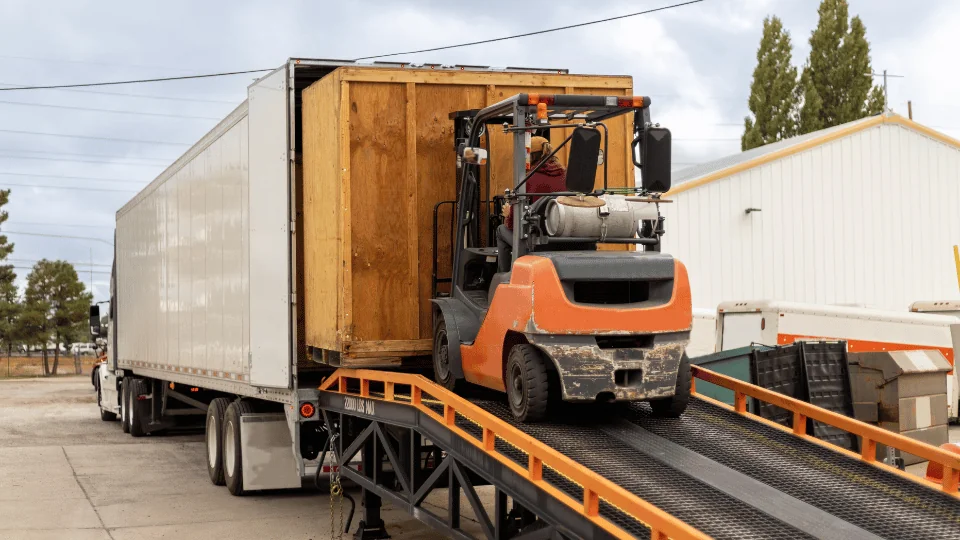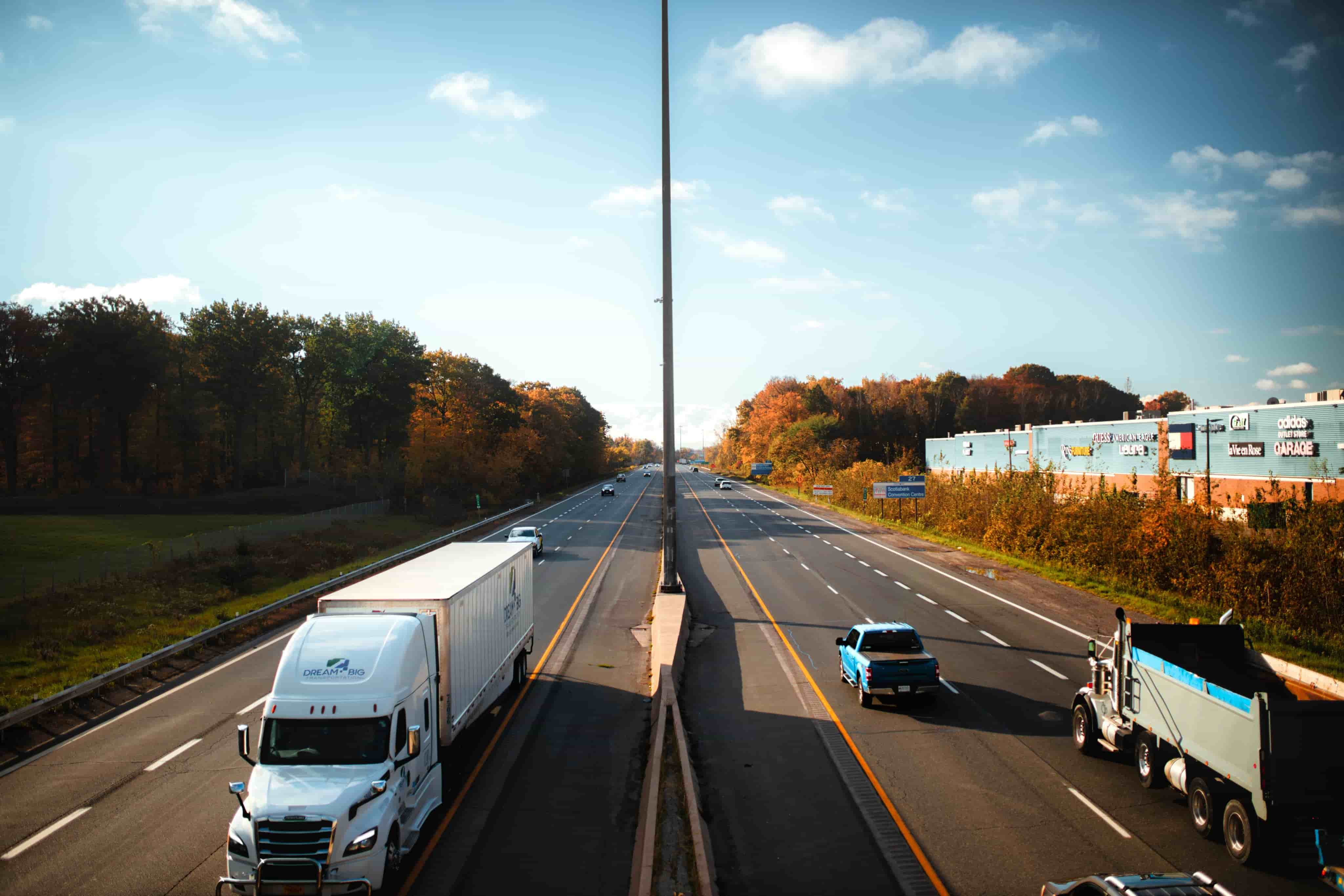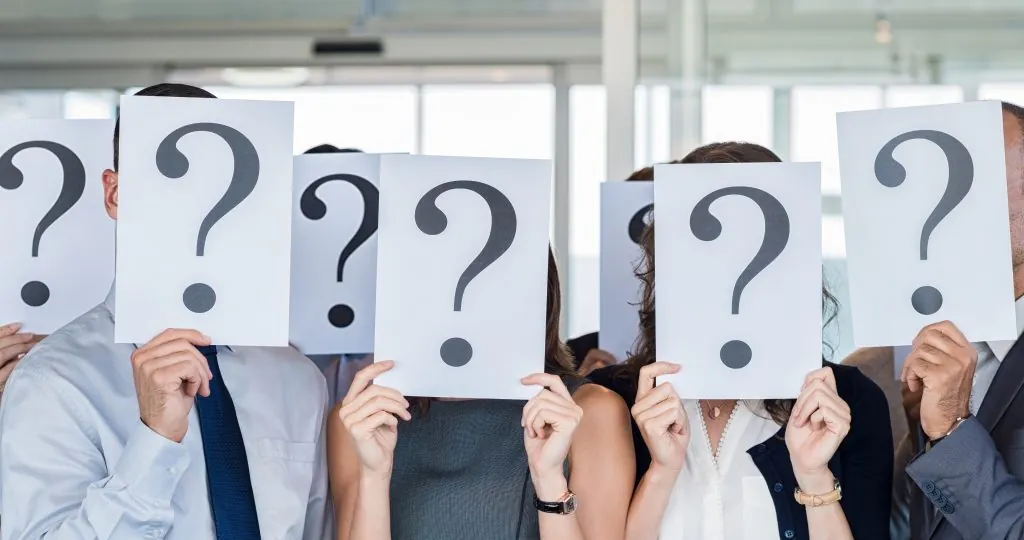
Moving Freight
Moving Your Freight with Ease
FreightCenter makes moving freight simple, fast, and affordable. Get instant quotes, expert support, and trusted carriers, all in one place!
Some More Resources on Moving Freight:
How to Ship Freight Most Common Freight Modes Best Shipping Methods for Your Freight Packaging FreightHow do you start moving freight?
Moving freight is a lot more challenging than it appears. Unlike parcel shipping, most people are unfamiliar with how to ship freight. However, business owners, retailers, and corporations rely on freight deliveries for their supplies, parts, and final products. Getting freight to and from your business or store is essential to reaching your customers and driving sales.
When it’s time to move freight, you need a process that’s simple, reliable, and cost-effective. FreightCenter specializes in helping businesses and individuals move freight across the country — and around the world — using a full range of freight transportation options. Whether you’re shipping a few pallets, heavy machinery, or delicate products, our experts are ready to guide you every step of the way.
Learn everything you need to know about moving freight safely, affordably, and efficiently with FreightCenter.
Thousands of businesses trust FreightCenter to move their freight faster, smarter, and cheaper! From unbeatable rates to top-notch service, our customers are raving about their shipping success.
See why they keep coming back!
Award-Winning Service, Trusted by Shippers Everywhere!
- 2021, 2017 & 2016 Food Logistics’ Top Green Providers
- 2021 & 2018 Supply & Demand Chain Executives’ Pros to Know: Matthew Brosious
- 2020 & 2019 Top Food Logistics’ 3PL & Cold Storage Provider Award
- 2020 & 2019 Business Observer’s Top 500 Companies on the Gulf Coast
- 2020 & 2017 SmartWay® Transport Partner
- 2020 & 2017 Food Logistics’ Champions: Rock Stars of the Supply Chain
- 2020 Best of Palm Harbor Awards for Local Businesses
- 2017 Green Supply Chain Award from Supply & Demand Chain Executive
- 2017 Tampa Bay Business Journal Heroes at Work
- 2016, 2015, & 2012 Food Logistics Top 100 Software and Technology Providers
- 2013 Tampa Bay Business 100 by Tampa Bay Business Journal
- 2013 Top 100 Great Supply Chain Partners by SupplyChainBrain
- 2012 TIA Samaritan Award Honorable Mention
- 2012, 2011 & 2010 TBBJ Fast 50 Recipient
- 2013, 2011, & 2010 Diversity Business Top Businesses

Why Choose FreightCenter for Moving Freight?
Instant Online Quotes: Our free online tool delivers real-time freight quotes in seconds. You can compare options and lock in rates without waiting on callbacks or jumping through hoops. We leverage our buying power and carrier relationships to secure better rates than you’d likely get on your own. That means lower costs for you, without compromising service.
Tailored Freight Solutions: No matter what kind of assistance you need for moving freight, FreightCenter has solutions that can enhance your freight shipping experience. From providing additional services like white glove delivery and lift gates, to offering third-party freight insurance and inside delivery/pickup, we customize your booking to your business needs.
Expert Freight Agents: Our team of experienced freight experts and customer service representatives is here to guide you from start to finish. Whether you need assistance with freight class, packaging, or paperwork, we’ve got you covered. From scheduling to delivery and every step in between, you’ll have reliable support when you need it most.
How to Move Freight: A Step-by-Step Guide for First-Time Shippers
If you’re new to moving freight, don’t worry! FreightCenter makes it easy for first-time shippers to get their feet wet and discover everything freight shipping has to offer. Whether you’re shipping a single pallet or a truckload, follow these simple steps to ensure a smooth and stress-free experience.
Step 1: Gather Your Shipment Details
Before you can get an accurate quote for your freight shipment, you will need to have the necessary information on your shipment so you can get as precise of a rate as you can get. When preparing to gather estimates from brokers and carriers, make sure you have the basics:
- Dimensions (length, width, height) and weight of each item or pallet
- Number of items/pallets in the shipment
- Type of items (e.g., furniture, machinery, food products)
- Pickup and delivery addresses, including ZIP codes
- Any special requirements (e.g., liftgate, residential delivery, inside pickup)
While you can obtain estimates based on rounded dimensions or quantities, your rate may fluctuate depending on any additional fees incurred along the way, resulting in your final pricing not accurately reflecting your initial quote. Be sure to have all your shipping information prepared in advance to receive a more precise quote.
Step 2: Get Your Freight Quotes
Once you are prepared, contact some carriers and freight brokers to get estimates. Every freight transportation company has its own way of calculating your quote; getting estimates from more than one company will be your best bet for both finding the right carrier for you and saving money on rates.
FreightCenter has a unique way of getting quotes: our free online quoting tool! You can use this feature to get instant rates from our network of carriers. All you have to do is fill in your shipment information, including:
- Whether you’ll be shipping LTL and or full truckload (more on that later)
- Your origin and destination ZIP codes
- Your freight’s weight and dimensions
- Your packaging type (e.g., pallet, crate)
- Any additional services you will need at pickup
- Your shipment’s freight class (for LTL only; if you don’t know it, don’t worry about it for now)
Once you finish filling out the form, click the “Get Quote” button. From there, just make a FreightCenter account and voila: instant quotes from several of our carriers, with initial rates, estimated transit times, and more. You can compare these rates side-by-side to make the best decision for your freight.
Step 3: Choose the Best Option for Your Shipment
Once you have received your quotes and chosen the best one for you, you can then further customize your booking. This includes doing things like:
- Reviewing delivery times, pricing, and carrier reliability
- Choosing the carrier and service level that fits your timeline and budget
- Filtering things like transit time, cost, or carrier rating
- Adding on additional services like third-party freight insurance or lift gates
You can also choose specifically what freight transportation mode you wish to utilize. The standard freight transportation for domestic travel is road (truck) shipping; however, you can also choose rail, ocean, or air freight shipping if you are handling international or cross-border shipments. You can also select intermodal shipping (using more than one type of transportation), but you may need to call a freight agent to complete this type of order.

Step 4: Book Your Shipment
After selecting your carrier and customizing your shipment, it’s time to finalize the details. If you are using FreightCenter, the steps to complete your booking are simple:
- Click “Book Now” to finalize your order
- Enter your contact info, pickup instructions, and any special delivery notes
- Confirm your shipment details and proceed to checkout
- You’ll receive your Bill of Lading (BOL) and instructions via email
You will also receive a phone call if it is your first time booking freight (or if you haven’t booked in a while) from one of our freight agents, who will review your booking and make any suggestions or answer any questions you have regarding moving your freight.
Step 5: Prepare and Package Your Freight
You’ve booked your shipment, so it’s time to prepare your freight! Your freight agent will provide you with some ideas on how to package your freight, and we also offer guides on how to do it properly. To avoid damage during transit, you should do the following while packaging your freight:
- Use sturdy pallets or crates and evenly distribute weight
- Secure items with shrink wrap, straps, or bands
- Label each pallet clearly with the destination and BOL info
- If shipping delicate or high-value goods, consider custom packaging or insurance (which you can include during booking)
On the day of your shipment, please confirm that your driver is on their way. They will contact you if they need to reschedule or delay pickup. You will need to move your freight to an appropriate pickup location. If you’re a business with a loading dock, you’re fine. However, residents or businesses without loading docks must move their freight to the curbside outside their building. If you need the driver to move your freight from a driveway or from within the building, an additional charge will apply.
Wait for the truck to arrive, load your freight into the truck (or onto the lift gate if you ordered one), and give a copy of the BOL to the driver. You’re all set!
Step 6: Track Your Shipment and Reorder Your Shipment
Once your freight is picked up, you can keep an eye on your shipment as it moves to its destination. If you booked with FreightCenter, you can log in to your FreightCenter account to track your shipment in real-time. You’ll receive updates and delivery confirmation once it reaches its destination. If anything changes or you have questions, our support team is just a call away.
If this is going to become a recurring shipment, you can easily reorder your shipment from your FreightCenter account. Simply find the shipment details and look for the “Book Again” button. You can also schedule pickups with your freight agent, eliminating the hassle of repeating the process each time you need a pickup. FreightCenter can take care of all that for you so you can focus on your core business objectives!
The mode of transportation you choose for moving freight depends on factors like the size and weight of the shipment, delivery timeline, the distance between delivery and pickup locations, and your budget. FreightCenter gives you access to every major mode and helps you choose the one that aligns best with your freight’s needs and your business goals so moving freight is a cinch.
Road freight shipping is the most flexible and widely used option, offering door-to-door delivery for everything from single pallets to full truckloads. It’s ideal for domestic freight thanks to its speed and convenience, especially for regional or short-haul moves. However, road freight can be affected by traffic, fuel prices, and weather-related delays. FreightCenter helps you navigate these challenges by giving you access to a vast network of LTL and FTL carriers, allowing you to compare prices, transit times, and services all in one place. Our experts assist with freight class, documentation, and scheduling to ensure a smooth shipping experience.
Rail freight shipping is a cost-effective solution for moving heavy or bulk shipments over long distances. It’s also one of the most environmentally friendly modes, making it a great choice for large volumes with less urgency. The downside is that it lacks door-to-door convenience and often requires truck transport at the start or end of the journey. That’s where FreightCenter’s intermodal expertise comes in. We coordinate the entire shipment — including the transitions between rail and truck — so you can enjoy the savings of rail without the logistical headache.
Air freight shipping is the fastest way to move freight, making it ideal for urgent shipments, high-value products, or perishable goods. It offers high levels of security and minimal handling, reducing the risk of damage. That said, air freight is typically the most expensive option and comes with strict weight, size, and hazardous material limitations. FreightCenter helps you make the most of this premium service by connecting you to top air cargo carriers, ensuring compliance with air freight regulations, and helping you balance speed with cost. We’ll guide you through packaging, booking, and airport coordination to keep your shipment on time.
Ocean freight shipping is the most economical way to ship freight internationally, especially large, heavy, or oversized cargo. With options like Full Container Load (FCL) and Less Than Container Load (LCL), it’s a great fit for businesses importing or exporting goods around the world. However, ocean freight can involve longer transit times, port congestion, and customs regulations that make the process more complex. FreightCenter simplifies international shipping by handling documentation, container selection, carrier booking, and customs coordination. We help you navigate the ports so your cargo arrives securely and on schedule.


FreightCenter Services That Benefit Shippers Moving Freight
Freight shipping can be complicated, especially when you try to handle it alone. Searching for carriers, getting quotes, understanding how to package and prepare your freight…all of it can be difficult for newcomers to manage on their own.
This is why partnering with a 3PL like FreightCenter is a brilliant idea for first-time freight shippers! FreightCenter can handle aspects of logistics that you may struggle to manage independently. Our services are designed to make moving freight easy and affordable, while also saving you money and time that can be allocated elsewhere in your operations.
Some of the services we provide via our partnerships with carriers and third-party providers include:
- Expedited Shipping Options
- Specialized Freight Services (Heavy Haul, Oversized, Hazardous Materials)
- White Glove Delivery Services
- Third-Party Custom Crating and Packaging Solutions
- Freight Class Assistance and NMFC Expertise
- Residential Freight Services
- Third-Party Freight Insurance Add-Ons
- Freight Consolidation Services
- Instant Online Booking and Tracking
Whether you’re new to freight shipping or a seasoned logistics manager, FreightCenter simplifies the process so you can focus on running your business. If you’re ready to experience everything we have to offer and start moving freight more easily, call (800) 716-7608 to speak with one of our freight agents, or try our free online quoting tool to compare and select carrier rates instantly today.
Frequently Asked Questions about Moving Freight

Q. What types of freight can I ship with FreightCenter?
You can move virtually any type of freight, from standard palletized goods to heavy machinery, temperature-sensitive items, hazardous materials, and high-value equipment. Common freight types include furniture, consumer goods, automotive parts, appliances, industrial equipment, and raw materials. FreightCenter collaborates with a diverse range of carriers and equipment types, enabling us to match your shipment with the most suitable service, whether you require a flatbed, reefer, step deck, or dry van.
Q. What is the easiest way to move freight?
The easiest way to move freight is to work with a freight broker or a third-party logistics (3PL) provider, such as FreightCenter. We simplify the process by helping you compare carriers, obtain instant quotes, and book your shipment online. With our platform, you don’t have to call around or manage multiple vendors; enter your details, choose your preferred service, and we’ll handle the rest, including paperwork, tracking, and support.
Q. What’s the difference between LTL and FTL shipping?
LTL (Less-Than-Truckload) shipping is ideal for smaller shipments that don’t require an entire truck. You only pay for the portion of trailer space you use, and your freight travels with shipments from other businesses. FTL (Full Truckload) shipping dedicates an entire truck to your freight, making it faster and more secure, especially for large or high-value loads. FreightCenter offers both LTL and FTL options, and our experts can help you decide which service best fits your shipment size, budget, and delivery timeline.
Q. How do I prepare freight for shipping?
Proper preparation is key to avoiding damage and delays. Start by measuring and weighing your freight accurately. Use pallets or crates to keep items secure, and wrap everything tightly with shrink wrap or straps. Label your freight clearly and ensure it’s accessible for pickup. If you’re unsure about packaging or have special items, FreightCenter offers resources and guidance to help you prepare your freight properly. We also assist with labeling, documentation, and selecting the right packaging materials.
Q. What documents are needed to move freight?
The most important document is the Bill of Lading (BOL), which acts as a contract between the shipper, carrier, and receiver. Other documents may include a packing list, commercial invoice (for international shipments), and insurance documentation. FreightCenter automatically generates your BOL during the booking process and sends it to you via email, ensuring you have everything needed for a successful shipment.
Q. How much does it cost to move freight?
Freight shipping costs vary depending on several factors, including the size and weight of your shipment, the distance it travels, the mode of transportation used, the freight class, and any accessorial services (such as liftgate delivery or residential drop-off). Prices also fluctuate based on market conditions and carrier availability. FreightCenter simplifies pricing by providing instant online quotes from top-rated carriers, allowing you to easily compare and select the best option for your budget and schedule.
Q. What are accessorial charges in freight shipping?
Accessorial charges are additional fees for services that go beyond standard pickup and delivery. Common examples include liftgate service, residential delivery, inside delivery, limited access pickup, and reclassification fees. FreightCenter helps you identify which accessorials apply during the quoting process and includes them in your estimate, ensuring no surprise charges.
Q. What’s the best way to save money when moving freight?
There are several ways to save: accurately measure your freight to avoid reweigh fees, consolidate shipments when possible, and choose flexible pickup and delivery dates. Booking in advance and comparing multiple carrier options also helps. FreightCenter’s platform makes it easy to compare your pricing options side by side, and our team can suggest cost-effective alternatives, such as switching from FTL to LTL or utilizing intermodal transportation when appropriate.
Q. How do I track my freight shipment?
You can track your shipment in real-time through FreightCenter’s online platform. Once your freight is booked and picked up, you’ll receive tracking information and updates along the way. Our tracking system displays the current location and estimated delivery window, keeping you informed from pickup to final delivery. If any issues arise or delays occur, our customer service team is here to help resolve them quickly.
Q. How long does it take to move freight?
Transit times depend on several factors, including the distance, carrier, transportation mode, and any service level upgrades (like expedited shipping). Domestic LTL shipments can take 2–5 business days, while FTL is often faster. Intermodal and ocean freight take longer, while air freight offers the fastest delivery. FreightCenter provides estimated delivery times for each carrier during the quoting process, so you can plan accordingly.
Q. What is freight insurance and do I need it?
Freight insurance protects your cargo against loss or damage during transit. While carriers offer limited liability coverage, it often falls short of covering the full value of your shipment. FreightCenter offers additional insurance options during the booking process, allowing you to select the right coverage for your freight. For high-value or fragile items, purchasing additional insurance is strongly recommended.
Q. Can FreightCenter move freight internationally?
Yes, FreightCenter offers international freight services through both ocean and air shipping. Whether you’re exporting or importing, we help you coordinate international shipments, navigate customs regulations, and choose the right container or cargo type. Our team can also assist with documentation, such as commercial invoices, bills of lading, and import/export permits, to ensure your freight crosses borders smoothly.
Q. Can FreightCenter help with oversized freight?
Absolutely. FreightCenter specializes in coordinating specialized and oversized freight shipments, including heavy equipment, construction machinery, and wide loads. We work with carriers that have the necessary permits, trailers (such as flatbeds and RGNs), and expertise to safely and legally move oversized cargo. Our team also helps with route planning and regulatory compliance to prevent delays and avoid fines.
Q. Why should I choose FreightCenter instead of going directly to a carrier?
FreightCenter provides access to a comprehensive network of carriers, enabling you to compare multiple quotes in one convenient location. That means better rates, more options, and more flexibility than you’d get from a single carrier. We also offer expert support, real-time tracking, and help with paperwork, freight class, and insurance — all wrapped into a single, easy-to-use platform. It’s shipping made smarter, not harder.
Q. How do I get an accurate FreightCenter quote?
The best way to get an accurate quote from FreightCenter is to use our free online quoting tool. Provide precise details of your shipment, including its weight, dimensions, and destination. FreightCenter’s platform will then generate quotes from a range of trusted carriers to help you find the best option. You can also call us at (800) 716-7608 to speak directly to a freight agent. We’ll help you get the best discounted rates for your shipments!
How to Package Freight the Right Way

Use Strong, Stackable Bases
Always place your freight on sturdy pallets or custom crates. This protects your cargo, allows forklift access, and prevents shifting during transit. Damaged bases = damaged freight.

Wrap, Cushion, and Secure
Protect your items with shrink wrap, bubble wrap, or foam padding. Secure them with straps or bands to prevent movement. FreightCenter recommends wrapping all loose items tightly.

Label Clearly and Completely
Every shipment should have clear, waterproof labels showing the destination, contact info, and BOL number. Proper labeling helps carriers deliver on time — and to the right place.


